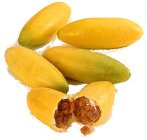Languages
Curuba

The Curuba or Banana passionfruit is closely related to the passion fruit. They look somewhat like a straight, small banana with rounded ends. The fruit is yellow-orange when ripe and contains a sweet edible orange-colored pulp with black seeds. There is more or less continuous fruiting the year around in Colombia. In New Zealand, the crop ripens from late March or early April to September or October.
The curuba is native to the Andean valleys from Venezuela to Peru. It was domesticated around the time of the Spanish Conquest and today it is commonly cultivated and its fruit are regularly sold in local markets. It is grown to some extent in Hawaii, India, New Guinea and New Zealand.
